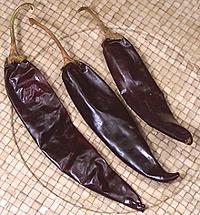One of my favourite aspects of home cooking is making something from scratch that most people would never dare to. Things like spice blends, sauces, condiments and curry pastes are usually store-bought and most cookbooks will assume that on the reader's behalf. You'll often see in cookbooks entries like "2 tablespoons store-bought xyz".
Unfortunately, most store bought "mélanges" feature the same problem that all processed food does: too much goddamn salt or too boring a flavour! So, today I'm going to show a few examples of blends, mixes and pastes that I make myself and find a damn sight better than anything I can find at the supermarket. Let's first look at Thai Red Curry Paste.
Thai Red Curry Paste
In the case of most Thai cooking, most recipes, including curries, ask for more salt than I'm comfortable using. But at least when you make it yourself you get to control the amounts of whatever the ingredients are. So, if you think the recipe's calling for too much salt or spice or whatever, who says you have to follow it to the letter? Cooking is always, ALWAYS about making food you want to eat the way you want to eat it.
Thai Red Curry Paste
In the case of most Thai cooking, most recipes, including curries, ask for more salt than I'm comfortable using. But at least when you make it yourself you get to control the amounts of whatever the ingredients are. So, if you think the recipe's calling for too much salt or spice or whatever, who says you have to follow it to the letter? Cooking is always, ALWAYS about making food you want to eat the way you want to eat it.
I first came across this Red Curry Paste recipe in a cheap little 5$ softcover Thai cookbook and have been tweaking it for years. But the basics as presented do make for a tasty, tasty curry. Now, most Thai Red Curry Paste recipes call for something called "shrimp paste", which is pretty much what it sounds like. Thing is, shrimp paste contains a metric frak-ton of sodium, and it goes bad a lot faster than someone like me can use it. So, I stopped bothering. I never found the shrimp paste added that much to the curry. Also, this allows for a vegetarian curry paste without really sacrificing any flavour.
Ingredients
- 10-12 red Thai chili peppers (also called "Bird's-eye peppers"), seeded and ribs removed - basically, using rubber gloves, slice each chili in half with a sharp knife, cut away all white parts (the "ribs") and rinse away the seeds under cold water. The seeds and ribs provide most of the heat. If you want a more fiery paste, keep some or all of the seeds and ribs. Don't say I didn't warn you though!
- 4 shallots, thinly sliced (I wouldn't recommend substituting onion in this case)
- 3 garlic cloves, chopped
- 1 tbsp chopped galangal (similar to ginger with more of a licorice flavour, available fresh at most Asian grocers) - substitute with ginger if not available
- 2 stalks lemon grass, chopped (you only want the soft middle part of the lemon grass, discard the wooden exterior)
- 5 fresh kaffir lime leaves, chopped (substitute with dry if fresh not available. Both can be found at Asian grocers, especially Thai ones. Go figure!)
- 4 fresh cilantro roots, chopped (when buying a bunch of fresh cilantro, chop off the roots and set aside to use for curry pastes)
- 10-12 black peppercorns
- 1 tsp ground coriander seeds
- 1/2 tsp ground cumin seeds
- pinch of cinnamon
- 1/2 tsp shrimp paste (purely optional)
- 2 tbsp olive or vegetable oil
Directions
To make the paste, all you have to do is toss all the ingredients into a food processor and pulse, adding a bit of oil at a time, until everything is well blended and "pasty". See below.
Not terribly "red", is it?Ingredients
- 10-12 red Thai chili peppers (also called "Bird's-eye peppers"), seeded and ribs removed - basically, using rubber gloves, slice each chili in half with a sharp knife, cut away all white parts (the "ribs") and rinse away the seeds under cold water. The seeds and ribs provide most of the heat. If you want a more fiery paste, keep some or all of the seeds and ribs. Don't say I didn't warn you though!
- 4 shallots, thinly sliced (I wouldn't recommend substituting onion in this case)
- 3 garlic cloves, chopped
- 1 tbsp chopped galangal (similar to ginger with more of a licorice flavour, available fresh at most Asian grocers) - substitute with ginger if not available
- 2 stalks lemon grass, chopped (you only want the soft middle part of the lemon grass, discard the wooden exterior)
- 5 fresh kaffir lime leaves, chopped (substitute with dry if fresh not available. Both can be found at Asian grocers, especially Thai ones. Go figure!)
- 4 fresh cilantro roots, chopped (when buying a bunch of fresh cilantro, chop off the roots and set aside to use for curry pastes)
- 10-12 black peppercorns
- 1 tsp ground coriander seeds
- 1/2 tsp ground cumin seeds
- pinch of cinnamon
- 1/2 tsp shrimp paste (purely optional)
- 2 tbsp olive or vegetable oil
Directions
To make the paste, all you have to do is toss all the ingredients into a food processor and pulse, adding a bit of oil at a time, until everything is well blended and "pasty". See below.
Really authentic Curry Paste is done up in a mortar and pestle, but it's time consuming and fairly coarse, which doesn't allow the flavours to blend as well. At least that's my opinion.
So, now all you have to do is use this homemade paste instead of store bought, and you'll make this version of Red Curry better by leaps and bounds. Trust me!
Spice Blends
Spice blends are one of my all-time favourite ways to play with flavours in fun ways that reflect what I like best. Now, I'll admit making your own spice blends is somewhat labour intensive. Who wants to whip together a curry powder from scratch when so many shops offer a wide and delicious variety? And in many cases, I'll agree. I've never bothered making my own curry powder, garam masala, herbes de provence, poultry seasoning, etc...
But there's at least one that I've come to find indispensable (Can you guess which one? Hint: it starts with a "b") and I think any BBQer worth his tongs should at least try to make their own personalized rib or pulled pork rub at some point. Which brings me to the next recipe.
In my last post, I talked about a local multicultural supermarket called Grace Ottawa that sells dried Guajillo, Arbol, Cascabel and Mulato chillies. Well, the next spice blend is one I invented using all four and a few other ingredients. But before I get into the recipe, I figure a little description of each chilli is warranted:
- Guajillo chillies

These are long, thin, fairly mild with smoky undertones and fruity/cocoa flavour. Think dark chocolate covered raisins.
- Arbol chillies

These are thin and quite small, basically similar in appearance to the Thai bird's-eye chilli but longer. These have a fairly straight-forward chilli heat and flavour, reminiscent of cayenne pepper but a little brighter. Essentially you could grind up a bunch of these into powder and use was a replacement for cayenne pepper with very little difference in flavour and heat.
- Cascabel chillies

These look a little like bell peppers, but much smaller (about the size of a small plum) and have a flavour similar to guajillo chilis, but with a bit more heat. They taste a bit like red wine.
- Mulato chillies

Mulato chillies are a bit weird looking, they're wrinkly like a raisin. They have minimal heat and a sweeter flavour with hints of licorice on top of the guajillo's fruity/chocolatey flavour. These are a common ingredient in molé sauce.
So, those are just a few chillies among many others commonly used in Mexican cooking, but also adapted by chefs around the world.
Now, the great thing about dried chillies (and many dried ingredients) is that with enough effort and patience, ANYTHING can become powder, which means anything can become a spice blend, and by extension, a rub for meat.
Another neat dried item I've found in multicultural/Asian groceries are dried kaffir lime leaves. While I prefer using fresh lime leaf when cooking Thai food (see above), I like the ability to pulverize into a powder that can add amazing flavour to spice blends.

Another fun seasoning to work with is star anise. Star anise has a (VERY!) strong licorice flavour and it's easy to go too far and it'll overpower whatever you're making. So use it sparingly.

When working with star anise, you'll only want to use part of the pod, unless you want enormous licorice flavour.
So, now to put all these crazy flavours together along with some friends in what I like to call Four Chilli Powder (I know, I'm Mr. Originality).
Four Chilli Powder Spice Blend
Before you get started on this, go buy a cheap coffee grinder. GO! NOW! OK, got it? Good, because without some kind of spice grinder, this whole effort is kinda futile.
Ingredients (adjust amounts and ratios as you see fit)
- 1 guajillo chilli
- 1 mulato chilli
- 3-4 arbol chillies
- 2 cascabel chillies
- 4-5 dried kaffir lime leaves
- 1/2 tsp whole coriander seeds
- 1/2 tsp whole cumin seeds
- 1/4 star anise pod (2 "arms" and seeds contained within)
- 2-3 green cardamom pods (you can crack the pods and just use the seeds, but I find the "shells" also infuse flavour. Whatever part of the pod doesn't get properly ground you can throw out)
- 1/2 tsp salt (I like to use smoked salt)
- 1 tsp smoked paprika (optional)
Directions
- In batches, depending on the size of your spice grinder, grind all ingredients until they become a powder (or as powdery as you want)
- Mix everything together in a bowl and store in glass jars
- For rib or pulled pork rub - Mix 1 part spice blend to 2-3 parts brown sugar (depending on how spicy you want to make your meat) and rub onto meat 12-24 hours before cooking, wrapping in plastic.
So, there you go, a couple more examples of how you can make your own personalized pastes, blends, etc. If there's one thing I encourage in the kitchen, it's to give your food your own touch! Enjoy! Play! Have fun! And if it sucks, at least you tried!
Cheers!

No comments:
Post a Comment